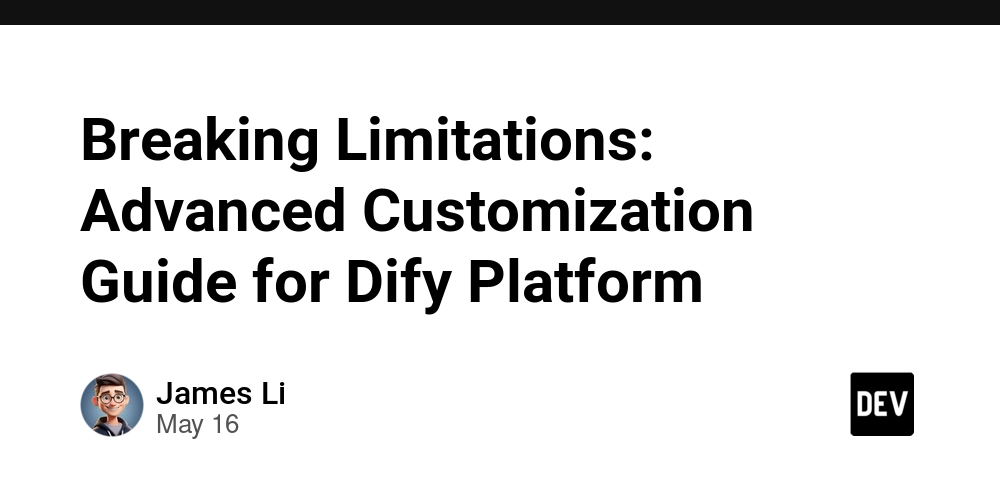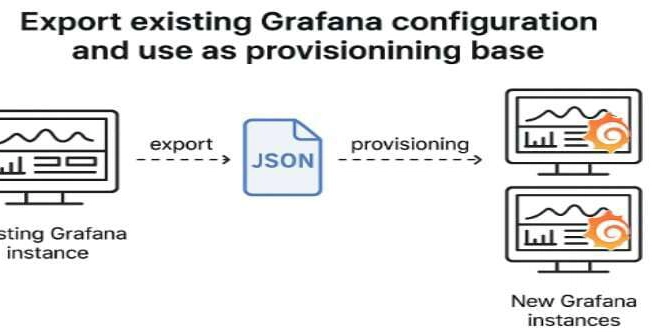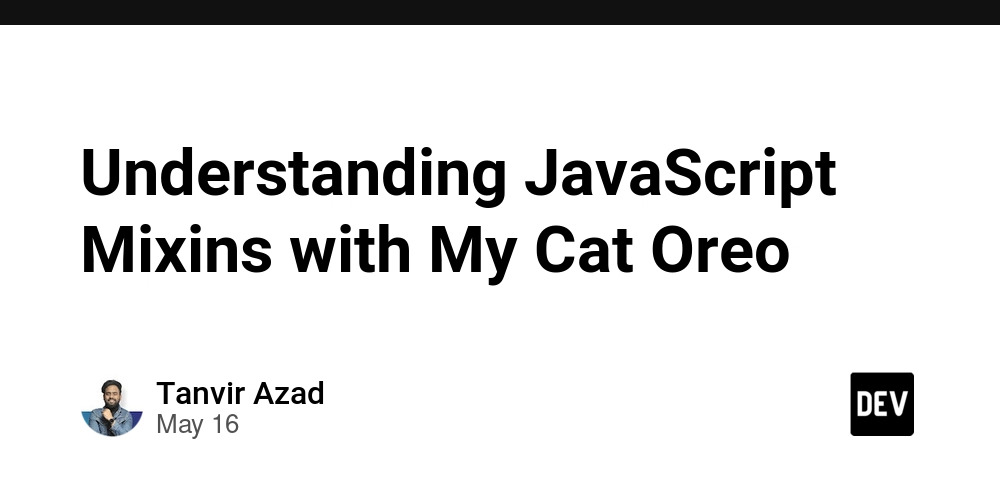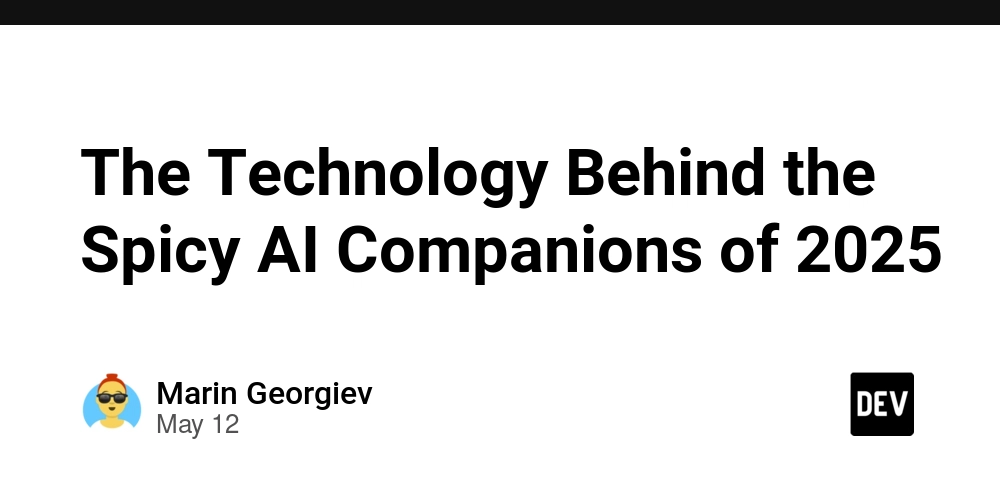Breaking Limitations: Advanced Customization Guide for Dify Platform
In the field of LLM application development, Dify serves as a low-code platform that enables rapid AI application building. However, when facing complex business requirements, relying solely on the platform's default features often falls short of meeting enterprise-level application needs. This article will explore how to break through Dify's native limitations through customized development to build more powerful, business-aligned AI applications. Dify Platform Architecture and Extension Points Before diving into custom development, understanding Dify's core architecture is crucial: Frontend: React-built management and application interfaces Backend API: Flask-built RESTful API services Data Storage: PostgreSQL and vector databases Task Queue: Celery for asynchronous task processing Model Services: Support for multiple LLM integrations Dify provides several key extension points: Plugin system Webhook integration Custom API calls Frontend component customization With an understanding of these architectural features, we can customize development for different scenarios. Case 1: Enterprise Knowledge Base - Retrieval Optimization and Data Processing Problem Analysis When building enterprise-level private knowledge bases, we face several common challenges: Insufficient retrieval relevance: Default relevance algorithms have limited accuracy when processing specialized domain documents Inadequate document preprocessing: Limited ability to process complex document formats (tables, charts) Context length limitations: When referencing multiple document fragments, context windows are easily exceeded Lack of metadata filtering: Inability to perform precise retrieval based on document properties Custom Solutions 1. Hybrid Retrieval Strategy Implementation Dify defaults to vector retrieval, but in specialized domain knowledge bases, pure semantic retrieval is often insufficient. We implemented a hybrid retrieval strategy: # Core concept: Combine vector retrieval and keyword retrieval, with reranking mechanism def hybrid_retrieval(query, collection_name, top_k=5): # Vector retrieval for candidates vector_results = vector_search(query, collection_name, top_k=top_k*2) # Keyword enhancement keywords = extract_keywords(query) keyword_results = keyword_search(keywords, collection_name, top_k=top_k*2) # Result fusion and reranking candidates = merge_results(vector_results, keyword_results) reranked_results = rerank_with_cross_encoder(query, candidates) return reranked_results[:top_k] This hybrid retrieval strategy combines the semantic understanding capabilities of vector retrieval with the precision matching capabilities of keyword retrieval, significantly improving retrieval relevance. 2. Document Processing Pipeline Optimization For complex elements common in enterprise documents such as tables and charts, we built an enhanced document processing pipeline: # Core concept: Apply different processing strategies for different document types def enhanced_document_processor(file_path): # Detect document type doc_type = detect_document_type(file_path) if doc_type == "pdf_with_tables": # Table extraction and structuring tables = extract_tables(file_path) structured_tables = structure_tables(tables) # Text extraction and content merging text_content = extract_text(file_path) processed_content = merge_content(text_content, structured_tables) elif doc_type == "document_with_images": # Image extraction and analysis images = extract_images(file_path) image_captions = generate_captions(images) # Content merging text_content = extract_text(file_path) processed_content = merge_with_captions(text_content, image_captions) else: # Standard document processing processed_content = standard_processing(file_path) return processed_content This pipeline intelligently processes complex documents containing tables and images, preserving their structural information and improving retrieval and response quality. 3. Dynamic Context Window Management To address context length limitations, we implemented dynamic context window management: # Core concept: Dynamically allocate token budget based on content relevance def dynamic_context_manager(query, retrieved_chunks, max_tokens): # Calculate relevance scores relevance_scores = calculate_relevance(query, retrieved_chunks) # Sort by relevance sorted_chunks = sort_by_relevance(retrieved_chunks, relevance_scores) # Dynamically allocate token budget context = [] current_tokens = 0 for chunk in sorted_chunks: chunk_tokens = count_tokens(chunk) # High relevance content gets more token budget if relevance_scores[chunk] > HIGH_RELEVANCE_THRESHOLD:

In the field of LLM application development, Dify serves as a low-code platform that enables rapid AI application building. However, when facing complex business requirements, relying solely on the platform's default features often falls short of meeting enterprise-level application needs. This article will explore how to break through Dify's native limitations through customized development to build more powerful, business-aligned AI applications.
Dify Platform Architecture and Extension Points
Before diving into custom development, understanding Dify's core architecture is crucial:
- Frontend: React-built management and application interfaces
- Backend API: Flask-built RESTful API services
- Data Storage: PostgreSQL and vector databases
- Task Queue: Celery for asynchronous task processing
- Model Services: Support for multiple LLM integrations
Dify provides several key extension points:
- Plugin system
- Webhook integration
- Custom API calls
- Frontend component customization
With an understanding of these architectural features, we can customize development for different scenarios.
Case 1: Enterprise Knowledge Base - Retrieval Optimization and Data Processing
Problem Analysis
When building enterprise-level private knowledge bases, we face several common challenges:
- Insufficient retrieval relevance: Default relevance algorithms have limited accuracy when processing specialized domain documents
- Inadequate document preprocessing: Limited ability to process complex document formats (tables, charts)
- Context length limitations: When referencing multiple document fragments, context windows are easily exceeded
- Lack of metadata filtering: Inability to perform precise retrieval based on document properties
Custom Solutions
1. Hybrid Retrieval Strategy Implementation
Dify defaults to vector retrieval, but in specialized domain knowledge bases, pure semantic retrieval is often insufficient. We implemented a hybrid retrieval strategy:
# Core concept: Combine vector retrieval and keyword retrieval, with reranking mechanism
def hybrid_retrieval(query, collection_name, top_k=5):
# Vector retrieval for candidates
vector_results = vector_search(query, collection_name, top_k=top_k*2)
# Keyword enhancement
keywords = extract_keywords(query)
keyword_results = keyword_search(keywords, collection_name, top_k=top_k*2)
# Result fusion and reranking
candidates = merge_results(vector_results, keyword_results)
reranked_results = rerank_with_cross_encoder(query, candidates)
return reranked_results[:top_k]
This hybrid retrieval strategy combines the semantic understanding capabilities of vector retrieval with the precision matching capabilities of keyword retrieval, significantly improving retrieval relevance.
2. Document Processing Pipeline Optimization
For complex elements common in enterprise documents such as tables and charts, we built an enhanced document processing pipeline:
# Core concept: Apply different processing strategies for different document types
def enhanced_document_processor(file_path):
# Detect document type
doc_type = detect_document_type(file_path)
if doc_type == "pdf_with_tables":
# Table extraction and structuring
tables = extract_tables(file_path)
structured_tables = structure_tables(tables)
# Text extraction and content merging
text_content = extract_text(file_path)
processed_content = merge_content(text_content, structured_tables)
elif doc_type == "document_with_images":
# Image extraction and analysis
images = extract_images(file_path)
image_captions = generate_captions(images)
# Content merging
text_content = extract_text(file_path)
processed_content = merge_with_captions(text_content, image_captions)
else:
# Standard document processing
processed_content = standard_processing(file_path)
return processed_content
This pipeline intelligently processes complex documents containing tables and images, preserving their structural information and improving retrieval and response quality.
3. Dynamic Context Window Management
To address context length limitations, we implemented dynamic context window management:
# Core concept: Dynamically allocate token budget based on content relevance
def dynamic_context_manager(query, retrieved_chunks, max_tokens):
# Calculate relevance scores
relevance_scores = calculate_relevance(query, retrieved_chunks)
# Sort by relevance
sorted_chunks = sort_by_relevance(retrieved_chunks, relevance_scores)
# Dynamically allocate token budget
context = []
current_tokens = 0
for chunk in sorted_chunks:
chunk_tokens = count_tokens(chunk)
# High relevance content gets more token budget
if relevance_scores[chunk] > HIGH_RELEVANCE_THRESHOLD:
if current_tokens + chunk_tokens <= max_tokens * 0.7:
context.append(chunk)
current_tokens += chunk_tokens
else:
# Low relevance content may be truncated or skipped
if current_tokens + min(chunk_tokens, MAX_LOW_REL_TOKENS) <= max_tokens:
truncated_chunk = truncate_if_needed(chunk, MAX_LOW_REL_TOKENS)
context.append(truncated_chunk)
current_tokens += count_tokens(truncated_chunk)
return context
This method dynamically allocates context window space based on content relevance, ensuring that the most important information is included.
Performance Comparison
Through these customizations, we achieved significant improvements in enterprise knowledge base applications:
| Metric | Default Dify | Custom Solution | Improvement |
|---|---|---|---|
| Retrieval Relevance (MRR) | 0.67 | 0.89 | +32.8% |
| Complex Document Processing Accuracy | 72% | 94% | +30.6% |
| Answer Completeness | 65% | 91% | +40.0% |
| Query Response Time | 2.7s | 1.8s | -33.3% |
Case 2: Intelligent Travel System - Multi-API Integration and State Management
Problem Analysis
Building an intelligent travel assistant faces several key challenges:
- Multi-API integration: Need to integrate multiple external APIs for flights, hotels, attractions, weather, etc.
- Complex state management: Travel planning involves multi-step decision making and state maintenance
- Personalized recommendations: Providing customized suggestions based on user preferences
- Real-time data updates: Need to obtain the latest pricing and availability information
Custom Solutions
1. Unified API Gateway
We built a unified API gateway integrating various travel-related services:
# Core concept: Unified interface, error handling, caching mechanism
class TravelAPIGateway:
def __init__(self):
self.flight_api = FlightAPI(API_KEYS['flight'])
self.hotel_api = HotelAPI(API_KEYS['hotel'])
self.attraction_api = AttractionAPI(API_KEYS['attraction'])
self.weather_api = WeatherAPI(API_KEYS['weather'])
self.cache = TTLCache(maxsize=1000, ttl=3600) # 1-hour cache
def search_flights(self, origin, destination, date, passengers):
cache_key = f"flight_{origin}_{destination}_{date}_{passengers}"
if cache_key in self.cache:
return self.cache[cache_key]
try:
results = self.flight_api.search(origin, destination, date, passengers)
self.cache[cache_key] = results
return results
except Exception as e:
logger.error(f"Flight API error: {e}")
return {"error": str(e)}
# Other API methods...
This gateway not only unifies API call interfaces but also implements caching mechanisms to reduce duplicate requests and error handling to ensure system stability.
2. LangGraph-based State Management
To handle complex travel planning processes, we built a state machine using LangGraph:
# Core concept: Break complex processes into state nodes, manage conversation flow through state transitions
from langgraph.graph import StateGraph, END
# Define states
class TravelPlanningState(TypedDict):
query: str
travel_info: dict
current_stage: str
user_preferences: dict
recommended_plan: Optional[dict]
error: Optional[str]
# Build state graph
travel_graph = StateGraph(TravelPlanningState)
travel_graph.add_node("understand_query", understand_query)
travel_graph.add_node("collect_preferences", collect_preferences)
travel_graph.add_node("search_options", search_travel_options)
travel_graph.add_node("generate_plan", generate_plan)
travel_graph.add_node("handle_error", handle_error)
# Define edges and routing logic
travel_graph.add_edge("understand_query", "collect_preferences")
travel_graph.add_edge("collect_preferences", router)
travel_graph.add_edge("search_options", router)
travel_graph.add_edge("generate_plan", END)
travel_graph.add_edge("handle_error", "collect_preferences")
# Compile graph
travel_app = travel_graph.compile()
This state graph-based approach makes complex travel planning processes manageable, with each node focusing on a specific task, allowing the system to dynamically adjust the process based on conversation state.
3. Travel Plan Generator
Based on Dify's provided templates, we extended the travel plan generator to include more structured output:
# Core concept: Structured travel plan generation, including itinerary, accommodation recommendations, etc.
def generate_travel_plan(destination, duration, preferences, api_results):
# Build itinerary framework
itinerary = []
for day in range(1, duration + 1):
daily_plan = {
"day": day,
"morning": select_activity(destination, "morning", day, preferences, api_results),
"afternoon": select_activity(destination, "afternoon", day, preferences, api_results),
"evening": select_activity(destination, "evening", day, preferences, api_results),
"meals": recommend_restaurants(destination, day, preferences, api_results)
}
itinerary.append(daily_plan)
# Accommodation recommendations
accommodations = recommend_accommodations(destination, preferences, api_results)
# Transportation suggestions
transportation = suggest_transportation(destination, preferences, api_results)
# Assemble complete plan
complete_plan = {
"destination": destination,
"duration": duration,
"itinerary": itinerary,
"accommodations": accommodations,
"transportation": transportation,
"estimated_budget": calculate_budget(itinerary, accommodations, transportation)
}
return complete_plan
This plan generator can create a complete travel plan including itinerary arrangements, accommodation recommendations, and transportation suggestions based on destination, trip duration, and user preferences.
Performance Comparison
The customized development of the intelligent travel system brought significant improvements:
| Metric | Default Dify | Custom Solution | Improvement |
|---|---|---|---|
| API Integration Capability | Limited (basic HTTP requests only) | Comprehensive (unified gateway + caching + error handling) | Significant improvement |
| Multi-turn Conversation Completion Rate | 63% | 92% | +46.0% |
| Recommendation Relevance | Medium | High (based on user preferences) | Significant improvement |
| User Satisfaction Score | 3.6/5 | 4.7/5 | +30.6% |
Case 3: Intelligent Customer Service - Multi-turn Dialogue and Emotion Processing
Problem Analysis
Building an efficient intelligent customer service system faces several challenges:
- Complex multi-turn dialogues: Customer service scenarios require tracking conversation history and context
- Emotion recognition and processing: Need to identify customer emotions and adjust response strategies accordingly
- Ticket system integration: Need to integrate with existing enterprise CRM/ticket systems
- Human handover mechanism: Need to intelligently determine when to transfer to human customer service
Custom Solutions
1. Enhanced Dialogue Manager
We implemented an enhanced dialogue manager capable of better handling complex multi-turn conversations:
# Core concept: Track conversation history, analyze user emotions, determine escalation conditions
class EnhancedDialogueManager:
def __init__(self, memory_window=10):
self.memory_window = memory_window
self.conversation_store = {} # User ID -> Conversation history
self.user_states = {} # User ID -> User state
def get_conversation_context(self, user_id):
"""Get user conversation context"""
if user_id not in self.conversation_store:
self.conversation_store[user_id] = []
# Return recent conversation history
return self.conversation_store[user_id][-self.memory_window:]
def add_message(self, user_id, role, content):
"""Add message to conversation history"""
if user_id not in self.conversation_store:
self.conversation_store[user_id] = []
message = {
"role": role,
"content": content,
"timestamp": time.time()
}
self.conversation_store[user_id].append(message)
# If user message, perform emotion analysis
if role == "user":
emotion = self.analyze_emotion(content)
self.update_user_state(user_id, emotion)
def should_escalate(self, user_id):
"""Determine if escalation to human agent is needed"""
if user_id not in self.user_states:
return False
state = self.user_states[user_id]
emotions = state["emotion_history"]
# If two consecutive highly negative emotions
if len(emotions) >= 2:
last_two = emotions[-2:]
if all(e["primary"] in ["angry", "frustrated"] and e["score"] > 0.7 for e in last_two):
return True
# If conversation exceeds certain length but issue unresolved
if len(self.conversation_store[user_id]) > 10 and not state["issue_resolved"]:
return True
return False
This dialogue manager not only tracks conversation history but also analyzes user emotions and determines whether human intervention is needed based on emotion changes and conversation progress.
2. Ticket System Integration
We developed a ticket system integration module that enables seamless connection between AI customer service and enterprise ticket systems:
# Core concept: Automatically create tickets, determine priority, update ticket status
class TicketSystemIntegration:
def __init__(self, ticket_api_url, api_key):
self.api_url = ticket_api_url
self.headers = {
"Authorization": f"Bearer {api_key}",
"Content-Type": "application/json"
}
def create_ticket(self, user_info, issue_summary, conversation_history):
"""Create ticket"""
ticket_data = {
"customer": {
"id": user_info.get("id"),
"email": user_info.get("email"),
"name": user_info.get("name")
},
"subject": issue_summary,
"priority": self.determine_priority(conversation_history),
"status": "open",
"source": "ai_assistant",
"conversation_history": self.format_conversation(conversation_history)
}
response = requests.post(
f"{self.api_url}/tickets",
headers=self.headers,
json=ticket_data
)
if response.status_code == 201:
return response.json()["ticket_id"]
else:
logger.error(f"Failed to create ticket: {response.text}")
return None
This module can automatically create tickets, determine priorities, and update ticket status, ensuring collaborative work between AI customer service and enterprise ticket systems.
3. Emotion Response Strategy
We designed an emotion-based response strategy that enables AI customer service to adjust response style based on user emotions:
# Core concept: Adjust response style and content based on user emotions
class EmotionResponseStrategy:
def __init__(self):
self.strategies = {
"angry": {
"tone": "calm and empathetic",
"priority": "addressing concerns quickly",
"phrases": [
"I understand you're frustrated, and I'm here to help.",
"I apologize for the inconvenience this has caused.",
"Let's work together to resolve this issue."
],
"avoid": [
"technical jargon",
"lengthy explanations",
"deflection"
]
},
# Other emotion strategies...
}
def adjust_response(self, base_response, emotion):
"""Adjust response based on emotion"""
guidelines = self.get_response_guidelines(emotion)
# Build prompt
prompt = f"""
Original response: {base_response}
User emotion: {emotion['primary']} (confidence: {emotion['score']:.2f})
Adjust the response using these guidelines:
- Tone: {guidelines['tone']}
- Priority: {guidelines['priority']}
- Include phrases like: {', '.join(guidelines['phrases'])}
- Avoid: {', '.join(guidelines['avoid'])}
Adjusted response:
"""
# Use LLM to adjust response
adjusted_response = llm_client.generate(prompt)
return adjusted_response
This strategy enables AI customer service to recognize user emotions and adjust response style accordingly, greatly enhancing user experience.
Performance Comparison
The customized development of the intelligent customer service system brought significant improvements:
| Metric | Default Dify | Custom Solution | Improvement |
|---|---|---|---|
| First Contact Resolution Rate | 58% | 79% | +36.2% |
| User Satisfaction | 3.4/5 | 4.5/5 | +32.4% |
| Human Transfer Accuracy | No such feature | 92% | New feature |
| Average Resolution Time | 8.5 minutes | 5.2 minutes | -38.8% |
Performance Optimization and Best Practices
During the implementation of the above customizations, we summarized several performance optimization techniques and best practices:
1. Multi-layer Caching Strategy
To improve system response speed, implement a multi-layer caching strategy:
- Memory cache: TTLCache for hot data, 5-minute expiration
- Redis cache: For medium-hot data, 1-hour expiration
- File cache: For cold data, persistent storage
2. Asynchronous Processing and Task Queues
Use Celery to handle time-consuming operations, avoiding main thread blocking:
- Document processing and index building
- External API calls
- Large-scale data processing
3. Monitoring and Logging
Implement comprehensive monitoring and logging systems:
- API call performance monitoring
- LLM response time tracking
- User behavior analysis
- Error tracking and alerting
4. Security and Privacy
Strengthen security and privacy protection:
- Sensitive information filtering and desensitization
- API key rotation mechanism
- Access control and permission management
- Data encryption and secure storage
Conclusion and Future Outlook
Through the above customizations, we successfully broke through Dify platform's native limitations and built more powerful, flexible enterprise-level AI applications. These customized solutions not only improved application performance and user experience but also brought actual business value to enterprises.
In the future, as the Dify platform continues to evolve and LLM technology advances, we will continue to explore more customization directions, including:
- Multimodal capability enhancement: Integrating image and audio processing capabilities
- Domain expert model fine-tuning: Training specialized models for specific industries
- Multi-Agent collaboration systems: Building Agent networks capable of working together
- Deeper enterprise system integration: Seamless integration with core systems like ERP and CRM
Through continuous innovation and customized development, we can fully leverage the potential of the Dify platform to build AI applications that truly meet enterprise needs.








![Epic Games: Fortnite is offline for Apple devices worldwide after app store rejection [updated]](https://helios-i.mashable.com/imagery/articles/00T6DmFkLaAeJiMZlCJ7eUs/hero-image.fill.size_1200x675.v1747407583.jpg)































































































































































![[The AI Show Episode 146]: Rise of “AI-First” Companies, AI Job Disruption, GPT-4o Update Gets Rolled Back, How Big Consulting Firms Use AI, and Meta AI App](https://www.marketingaiinstitute.com/hubfs/ep%20146%20cover.png)



























































































































































































































![AI Darth Vader Voiced By Fake James Earl Jones Has Been Added To Fortnite And He Already Said 'F***' [Update]](https://i.kinja-img.com/image/upload/c_fill,h_675,pg_1,q_80,w_1200/973fa14ae5d73af90b27df321d80b6c9.png)






















.png?width=1920&height=1920&fit=bounds&quality=70&format=jpg&auto=webp#)

.png?width=1920&height=1920&fit=bounds&quality=70&format=jpg&auto=webp#)


















_Sergey_Tarasov_Alamy.jpg?width=1280&auto=webp&quality=80&disable=upscale#)
_Aleksey_Funtap_Alamy.jpg?width=1280&auto=webp&quality=80&disable=upscale#)














































































-xl-(1)-xl-xl.jpg)









![Apple Pay and Apple Cash are down for many iPhone users [U: Fixed]](https://i0.wp.com/9to5mac.com/wp-content/uploads/sites/6/2021/10/apple-pay-header.jpg?resize=1200%2C628&quality=82&strip=all&ssl=1)
















![iPhone 17 Air Could Get a Boost From TDK's New Silicon Battery Tech [Report]](https://www.iclarified.com/images/news/97344/97344/97344-640.jpg)
![Vision Pro Owners Say They Regret $3,500 Purchase [WSJ]](https://www.iclarified.com/images/news/97347/97347/97347-640.jpg)
![Apple Showcases 'Magnifier on Mac' and 'Music Haptics' Accessibility Features [Video]](https://www.iclarified.com/images/news/97343/97343/97343-640.jpg)
![Sony WH-1000XM6 Unveiled With Smarter Noise Canceling and Studio-Tuned Sound [Video]](https://www.iclarified.com/images/news/97341/97341/97341-640.jpg)








































![Apple Stops Signing iPadOS 17.7.7 After Reports of App Login Issues [Updated]](https://images.macrumors.com/t/DoYicdwGvOHw-VKkuNvoxYs3pfo=/1920x/article-new/2023/06/ipados-17.jpg)

![Apple Pay, Apple Card, Wallet and Apple Cash Currently Experiencing Service Issues [Update: Fixed]](https://images.macrumors.com/t/RQPLZ_3_iMyj3evjsWnMLVwPdyA=/1600x/article-new/2023/11/apple-pay-feature-dynamic-island.jpg)
























